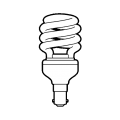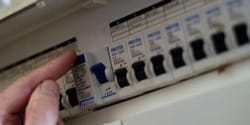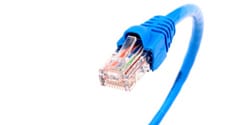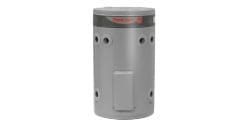What types of lights are there?
When it comes to the range of lighting currently available on the market, it can be a pretty overwhelming sight to consider. Blue lights, red lights, white lights, tall, short, fat, thin, LED, Halogen, Fluorescent… the list goes on. That’s even before you start going to into the totally different world of smart lighting!


To try and help with the daunting task of trying to figure out all the light types, we have collected some information regarding the different types of lights, their advantages, disadvantages and how they work. If you would like to know some more information regarding lighting solutions, give Captain Cook Electrical a call on 1300 911 307 today.
What types of lights are there?
There are four main types of lights, or light bulbs, currently available on the market:
- Incandescent.
- CFL, or compact fluorescent lamp.
- Halogen.
- LED, or light emitting diodes.
Incandescent light bulb


An incandescent light bulb is the traditional style of globe, and is the most commonly used option over the last 100 years or so. They are not that efficient to run though, compared to newer styles on the market, and incandescent light bulbs are also pretty pricey to run. A phase out of this kind of globe started in 2009.
CFL light bulb


A CFL light bulb is also known as a compact fluorescent lamp, and is a relatively cost effective and energy efficient option when compared to both incandescent and halogen light bulbs. It is noted however that small amounts of mercury are contained in the bulbs.
Halogen light bulb


Halogen light bulbs work in a similar way to incandescent globes, however contain halogen gas (which makes them more energy efficient). They also run for longer periods than incandescent bulbs.
LED light bulb


LED light bulbs, also known as light emitting diodes, are the most cost effective and energy efficient lighting options on the market.
How do they work?
Each light type works slightly differently, depending on its internal structure:
- Incandescent Light Bulb: Firstly, an incandescent light bulb works by sending an electric current though the tungsten filament (the little wire you see in a globe) until it heats up. It glows brighter and brighter the hotter it gets, which is known as lumens, and the energy levels rise too. More energy = more wasted energy though.
- CFL Light Bulb: A CFL light bulb, and fluorescent tubes, use an identical method to create light. An electric charge is created in a tube filled with mercury vapour, with the charge exciting the vapour. When the vapour is excited, it lets off UV light which then excites the phosphor lining of the tube. Excited phosphor = light!
- Halogen Light Bulb: A halogen light bulb operates in the same way that an incandescent one does, but the globe contains halogen gas. This gas speeds up the entire process, meaning they are both more cost effective and more energy efficient than their incandescent counterparts… and they last longer too!
- LED Light Bulb: Finally, an LED globe works differently to all other options. An electric charge is sent through solid material, which engages the electrons within it and encourages them to move faster and faster. This movement creates light and generates less heat, making them both energy efficient and cost effective.
What are the advantages and disadvantages?
Each light types has positives and negatives associated with them, just like anything. A few of the major points are listed below,
Incandescent Light Bulbs
Advantages
- Most common light bulb for 100+ years.
- Simple and cheap to manufacture.
- Cheap to buy.
- Best suited to small areas.
- Made with non-toxic materials.
Disadvantages
- Inefficient to run, as most electrical energy is converted into heat (not light).
- Don’t last very long.
- Not good to light large areas.
- Generally phased out except for speciality uses e.g. oven lights.
CFL Light Bulbs
Advantages
- More energy efficient than incandescents and halogens.
- More cost effective than incandescents and halogens.
- Generate very little heat.
- Highly versatile.
- Can work with dimmers.
Disadvantages
- Cold temperature sensitive.
- Don’t last very long.
- Not recommended for fixtures that are enclosed.
- Longer warm up time.
Halogen Light Bulbs
Advantages
- More energy efficient than incandescents.
- More cost effective than incandescents.
- Quite cheap to buy.
- Clear crisp light.
- Compact size.
Disadvantages
- Inefficient to run.
- Don’t last very long.
- Run hotter than incandescents.
- May require low voltage transformer.
LED Light Bulbs
Advantages
- Most cost effective option.
- Most energy efficient option.
- Last for long period of time.
- Generate little to no heat.
- Small in size.
Disadvantages
- Can be voltage sensitive.
- More expensive than other options.
- Depend heavily on the temperature around them to perform properly.
- Do not give spherical light distribution (not overly advisable for larger areas)
How do they compare?
So, how do the 4 light globes compare to each other? As can be seen above, each has their pros and cons, but here it is in an easy-to-read-format (courtesy of Energy Rating):
| LED (light emitting diode) | CFL (compact fluorescent lamp) | Halogen | Circular and linear fluorescent | |
|---|---|---|---|---|
| Typical omnidirectional light bulb and price |   |   |   |   |
| Typical directional light bulb and price |   |   |   | N/A |
| Colour range | Warm White to Daylight | Warm White to Daylight | Warm White | Warm White to Daylight |
| Dimmable | Selected Brands | Selected Brands | Yes | No |
| Life span (hours) | 15,000 – 30,000 | 6,000 – 15,000 | 2,000 – 4,000 | 10,000 |
| Replacement globes (over 10 years) | 1 | 2 | 5 | 1 |
What about lighting types?
Lighting types, as opposed to light types, are different things. Light types refers to the light bulb, such as halogen or LED, whereas lighting types refers to the type of actual light. The three most basic lighting types are task, accent and general, which generally all work together to light an area.

The lighting experts you need
We provide electrical services in North Shore, Northern Beaches, Eastern Suburbs, Hills District and Ryde.
If you need some assistance with your home or business lighting, give Captain Cook Electrical a call on 1300 911 307 or complete an online job booking form today. We are your lighting solution experts, so get in contact now!
Resources:
CHOICE (How to buy the best light bulbs): https://www.choice.com.au/home-improvement/energy-saving/light-bulbs/buying-guides/light-bulbs
Energy Rating (Choose Which Type of Bulb): http://www.energyrating.gov.au/lighting/types-of-light-bulbs
Energy Rating (Factsheet: Light Bulb Buyers Guide): http://www.energyrating.gov.au/document/factsheet-light-bulb-buyers-guide
*Note: All black and white pictures contained on this page are courtesy of the Energy Rating Light Bulb Buying Fact Sheet and Energy Rating: Choose a Light Bulb.



